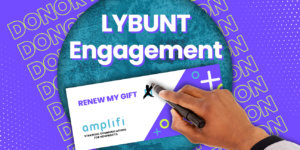Providing a thorough, engaging, and user-friendly experience for online donors is a must for modern fundraisers. After all, your website is the online home for all your regular initiatives and a platform to broadcast why your work is so important.
But a separate campaign microsite can be a helpful tool for your capital campaigns and other large one-off initiatives that fall outside your regular fundraising.
You don’t want to overwhelm donors with too much information. So, don’t cram details about all your fundraising campaigns onto your main donation or landing page!
Maybe you have a tab on your organization’s homepage for every separate program? If so, your campaigns might actually be competing for attention!
Your nonprofit’s microsite will provide donors with a more focused experience. It should strengthen the identity of a campaign, explain what sets it apart from your other initiatives, and describe how it furthers your mission.

Building Your Campaign Microsite
A powerful campaign microsite will drive you towards your campaign’s goal. There are five fundamental pages you need to guide your visitors towards making a gift:
Home Page
Think of your campaign’s main page like a digital, living brochure. The homepage should contain essential information about the campaign in a scaled down, focused design.
So don’t overload visitors with details as soon as they land on your nonprofit’s microsite. This page should make them want to learn more about your campaign and why they should help.
Campaign Progress
Keep this page up to date so donors know how close you are to reaching your goal.
Use a visual tool like a progress bar so donors can get a better picture of how the campaign is going. This is especially important for capital campaigns. When you’re talking about millions of dollars, it’s important to have a visual representation to make an obscure number feel less abstract.
Report on metrics like the percentage you’ve raised towards your goal. Or report how many total donors have participated in the campaign.
Don’t focus strictly on dollars raised. Instead, get creative and put things in perspective for donors. This creates a more inclusive environment for giving.
Afterall, it’s not really about the money. This campaign, the funds you raise, and what you’re going to accomplish with them are all just a way to further your mission!
Donation Page
Let’s be realistic, you probably won’t secure that campaign changing gift from someone who stumbles across your campaign microsite for the first time.
But you should give donors who want to give something online the option to! Make sure your giving page is easy to use and accepts multiple forms of payment.
Remember, nonprofit websites with mobile-responsive design can increase donations by 126 percent, according to Nonprofit Source. So, make sure your site works well on a smartphone or tablet.
Include a separate “contact us” form for donors who want to learn more about your organization. These people could be interested in making a larger gift after learning more about this initiative. So, make sure you follow up on all requests for more information!
Are you still in the quiet phase and not yet open to public donations? Use this page to let donors know who to contact if they want to get involved. Or, hide your donation page during the quiet phase and publish it after the official public launch.
Goals Page
You can use your nonprofit’s microsite to explain the main goals of your campaign in a way that demonstrates the impact of your project.
Many organizations center campaigns on a “four pillars” model. You goals page should show what the core tenets of your campaign look like in action and tie them into your nonprofit’s overarching mission.
Leadership Information
This page showcases a campaign’s committee members and other individuals spearheading the initiative.
Your beneficiaries are at the center of your campaign’s story, which is featured on your home page. But your donors might want to know a little more about the people driving the campaign!
Some organizations choose to feature leadership donors on this page. This adapts your microsite into a stewardship tool and can encourage others to contribute

Apply Modern Web Design
You can provide an even smoother experience for your visitors with a single-page campaign microsite. This approach guides visitors as they scroll your page and digest your message.
A single-page site presents information in the order that you intended, rather than relying on visitors to click on tabs. But you can still include navigation links that let visitors jump to specific sections of your nonprofit’s microsite.
However, using a single-page website requires some special attention. This approach aims to do more with less, so strong editing and content organization skills are a must for any web designer faced with this task!
You will also need to get down to the core of your message and present your content concisely while evoking emotion and encouraging engagement.
Whether you run with a modern, single page design or use a more traditional layout ultimately comes down to your organization’s preference. We’ve seen both styles effectively support campaigns!
Connecting the Dots
Your campaign microsite should be immediately distinguishable from your main website. It needs to re-enforce the brand you established in your case statement, brochure and other communications. You can borrow images, fonts, and other design elements for your microsite to help donors make the connection.
Take the stories and other messages from your direct mail appeals and reframe them for your online visitors. Unlike a print appeal, your microsite can keep up with the story. So, let donors know about the impact of the progress you are making on this initiative!
Make sure you are clear on your campaign microsite’s donation page. Donors should understand their contributions go towards a specific cause, not your annual or general fund.
Then, explain the impact this program will have on your mission. Your donors want to know how this specific project fits into and furthers the values they share with your nonprofit.







